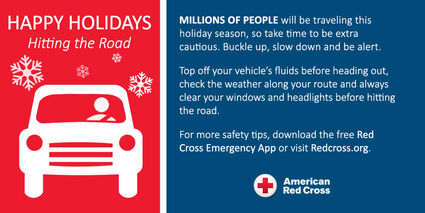Stay Safe: Winter is Coming to Town
Last updated 12/21/2022 at 12:05pm
Wednesday, December 21, 2022 - The National Weather Service reports unusually cold air will cover the country this week with temperatures as much as 20 degrees below normal. The American Red Cross has steps you should take to stay safe if you are in the path of this winter weather.
WINTER DRIVING SAFETY
Stay off the road if possible, during severe weather. If you must drive in winter weather, follow these tips:
Keep in your vehicle:
1. A windshield scraper and small broom. A small sack of sand for generating traction under wheels and a set of tire chains or traction mats. Matches in a waterproof container. A brightly colored (preferably red) cloth to tie to the antenna
2. An emergency supply kit, including warm clothing.
Keep your vehicle’s gas tank full to keep the fuel line from freezing.
Make sure everyone has their seat belts on and give your full attention to the road.
Don’t follow other vehicles too closely. Sudden stops are difficult on snowy roadways.
Don’t use cruise control when driving in winter weather.
Ramps, bridges, and overpasses freeze before roadways.
If you become stranded:
Stay in the vehicle and wait for help. Do not leave the vehicle to search for assistance unless help is visible within 100 yards (91 meters). You can quickly become disoriented and confused in blowing snow.
Display a trouble sign to indicate you need help. Hang a brightly colored cloth (preferably red) on the radio antenna and raise the hood after snow stops falling.
Run the engine occasionally to keep warm. Turn on the engine for about 10 minutes each hour (or five minutes every half hour). Running the engine for only short periods reduces the risk of carbon monoxide poisoning and conserves fuel. Use the heater while the engine is running. Keep the exhaust pipe clear of snow, and slightly open a downwind window for ventilation.
Leave the overhead light on when the engine is running so that you can be seen.
STAY SAFE OUTSIDE
Wear layered clothing, mittens or gloves, and a hat.
Cover your mouth to protect your lungs from severely cold air.
Watch for signs of hypothermia and frostbite.
Keep dry. Change wet clothing frequently to prevent a loss of body heat. Wet clothing loses much of its insulating value and transmits heat rapidly away from the body.
Stretch before you go out. If you go out to shovel snow, do a few stretching exercises to warm up your body. This will reduce your chances of muscle injury.
Avoid overexertion, such as shoveling heavy snow, pushing a vehicle, or walking in deep snow. The strain from the cold and the hard labor may cause a heart attack. Sweating could lead to a chill and hypothermia.
Walk carefully on snowy, icy sidewalks. Slips and falls occur frequently in winter weather, resulting in painful and sometimes disabling injuries.
If you must go out during a winter storm, use public transportation if possible. About 70 percent of winter deaths related to ice and snow occur in automobiles
WINTER WEATHER SAFETY
Caulk and weather-strip doors and windowsills to keep cold air out. Install storm windows or cover windows with plastic from the inside to provide an extra layer of insulation to keep cold air out.
Make sure you have enough heating fuel on hand.
Stay indoors and wear warm clothes. Layers of loose-fitting, lightweight, warm clothing will keep you warmer than a bulky sweater. If you feel too warm, remove layers to avoid sweating; if you feel chilled, add layers.
Check on relatives, neighbors, and friends, particularly if they are elderly or if they live alone.
Protect pipes from freezing.
If possible, bring your pets inside during cold winter weather. Move other animals or livestock to sheltered areas and make sure they have access to non-frozen drinking water. If the animals are outside, make sure their access to food and water is not blocked by snow drifts, ice or other obstacles.
DOWNLOAD RED CROSS APPS The Red Cross app “Emergency” can help keep you and your loved ones safe with real-time alerts, shelter locations and safety advice. The Red Cross First Aid App provides instant access to information on handling the most common first aid emergencies. Download these apps for free by searching for ‘American Red Cross’ in your app store or at redcross.org/apps.
About the American Red Cross:
The American Red Cross shelters, feeds and provides comfort to victims of disasters; supplies about 40% of the nation's blood; teaches skills that save lives; distributes international humanitarian aid; and supports veterans, military members and their families. The Red Cross is a nonprofit organization that depends on volunteers and the generosity of the American public to deliver its mission. For more information, please visit https://www.redcross.org/local/texas/gulf-coast.html or cruzrojaamericana.org, or visit us on Twitter at @RedCrossTXGC.








Reader Comments(0)